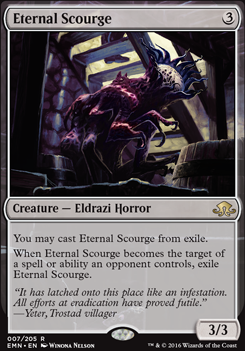Introduction
This is an adaptive deck for cEDH that primarily plays a midrange plan before trying to win through one of several combos. While the deck can't power out a win as quickly as some of the fastest deck, it regains a lot of value from recovering and pivoting very reliably while interacting well both on the board and on the stack.
The Combos: How to Win
The deck runs a great number of different combos that aim to avoid different counters. This also allows us to pivot into a second and third plan very easilysince there are always ways to win without any specific card.
Demonic Consultation + Thassa's Oracle
and Tainted Pact + Thassa's Oracle
are both instant win conditions through exiling your entire library and resolving Oracle's trigger.
Aluren + Cavern Harpy + Ukkima, Stalking Shadow
wins at instant speed by infinitely performing a loop where we play Ukkima for free through Aluren followed by playing Harpy for free the same way. Harpy bounces Ukkima back to hand and Ukkima drains an opponent for 2, Harpy then bounces itself by us paying 1 life and we repeat.
Acererak the Archlich + Aluren
also wins in a similar way by casting Acererak an infinite number of times and winning from venturing into the Lost Mines of Phandelver where the third room will drain our opponents to death.
Both of the Aluren combos can also be executed at sorcery speed through generating infinite colored mana, which the deck does in the following ways:
- Dramatic Reversal + Isochron Scepter
- Incubation Druid + Vigean Graftmage
- Food Chain + Misthollow Griffin
or Eternal Scourge + Food Chain
The infinite mana can also be used alongside Altar of Dementia to win through infinately recasting either of our commanders, and the infinite mana from Food Chain can be used to loop Ukkima through Food Chain to drain our opponents infinitely.
The Support: Not Getting Stopped
The deck runs a in great colors for tutors and mixes the generically best tutors like Demonic Tutor and Vampiric Tutor with spell tutors like Spellseeker and Mystical Tutor as well as creature tutors like Eldritch Evolution and Neoform. This means that we both have strong options to quickly get what we need and tidy ways to chain tutor when necessary. We also run several powerful card advantage engines in Mystic Remora, Rhystic Study, Dark Confidant, Sylvan Library and Rashmi, Eternities Crafter supplemented by a small wheel package of Timetwister, Windfall and Whispering Madness combined with Notion Thief and Narset, Parter of Veils and the single ultra explosive draw spell in Ad Nauseam.
For mana we primarily look for fast colored mana. Due to this, we are not running Crypts and Monoliths but rather dorks like Birds of Paradise, Elves of Deep Shadow and Deathrite Shaman as well as Carpet of Flowers, Chrome Mox and Mox Diamond since they provide colored mana.
(Currently the deck is not running any rituals, but that may change in the future.)
Lastly, Sultai has great access to interaction and we run a package of the most solid choices. Abrupt Decay, Assassin's Trophy and Geistwave among others allow us to deal with most problematic permanents and stack interaction ranging from Dispel and Force of Will to Veil of Summer and Misdirection all mean we can engage in counter wars without large mana investments. We can even handle strategies that go wide by tutoring for Toxic Deluge or Cyclonic Rift.
Weaknesses: What to Watch Out For
The deck may be very strong in its ability to adapt, but there are still counters that are hard to get around. With most of our combos involving several moving pieces, we are vulnerable to interaction and should aim to be able to protect ourselves as we go off. Additionally, we may struggle to break through stax pieces that limit the use of activated abilities of creatures, artifacts or enchantments (depending on what combo we are attempting) and limits on tutoring for or drawing into our pieces. These obstacles are all annoying and should be on our minds as we navigate the game. But the deck is built for adapting to the conditions of the table and eventually we will assemble a combo that can win through the current board state - unless we run into the one hard counter to our combo strategies: Rule of Law effects. These effects stop us from attempting any of our combo wins, and they need to go before we can try to close out the game.
Final Thoughts
Playing Sultai in cEDH is very fun to me, and feels much more interactive without losing power compared to more explosive decks featuring red. We have some really awesome staying power, and we can push for a win time and time again while proficiently keeping our opponents from winning. It's a fun way to play that strikes the balance between turbo and stax, giving up just a little speed and a little control for finding the power in the mid range.



![The Wolf of Maul Street [8] thumbnail](http://static.tappedout.net/chart/0-40-20-0-40-small.png)